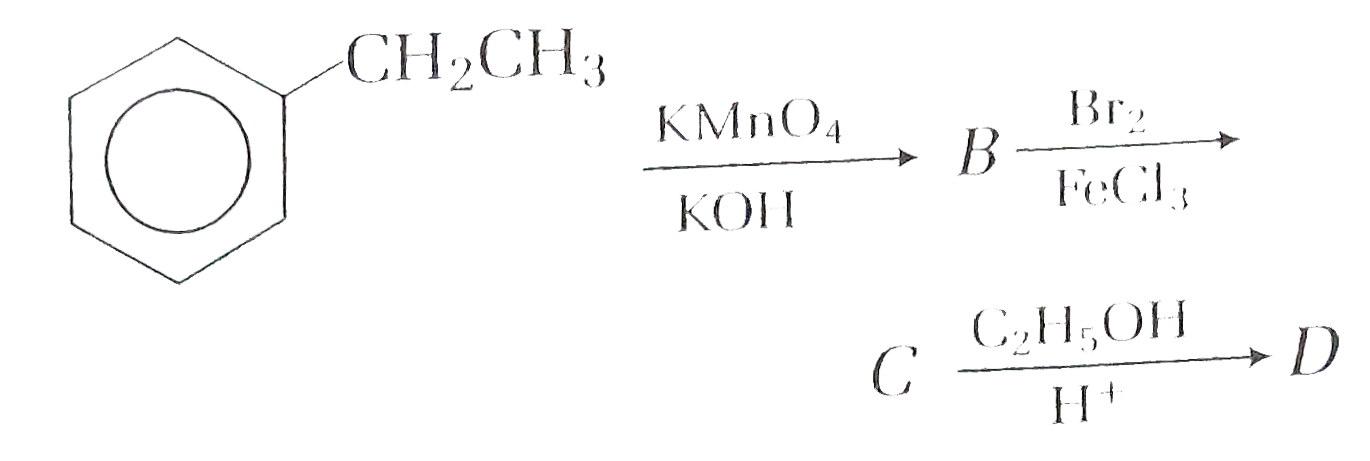A set of reactions yielded a product (D):
CH3COOHSOCl2−−−→(A)Benzene−−−−−−−→anhyd.AlCl3(B)HCN−−→(C)HOH−−→(D)
The structure of (D) would be:




The correct Answer is:A
To solve the problem step by step, we will analyze each reaction and determine the structure of the final product (D).
Step 1: Reaction of Acetic Acid with SOCl2
- Starting Compound: Acetic Acid (CH₃COOH)
- Reaction: Acetic acid reacts with thionyl chloride (SOCl₂).
- Product: The hydroxyl group (-OH) in acetic acid is replaced by a chlorine atom (-Cl), forming acetyl chloride (CH₃C(=O)Cl).
Structure:
- CH₃C(=O)Cl (Acetyl chloride)
Step 2: Friedel-Crafts Acylation with Benzene
- Starting Compound: Acetyl Chloride (CH₃C(=O)Cl)
- Reagent: Benzene (C₆H₆) and anhydrous aluminum chloride (AlCl₃).
- Reaction: This is a Friedel-Crafts acylation reaction where the acetyl group is introduced to the benzene ring.
- Product: The product formed is acetophenone (C₆H₅C(=O)CH₃).
Structure:
- C₆H₅C(=O)CH₃ (Acetophenone)
Step 3: Reaction of Acetophenone with HCN
- Starting Compound: Acetophenone (C₆H₅C(=O)CH₃)
- Reagent: Hydrogen cyanide (HCN).
- Reaction: The carbonyl group (C=O) in acetophenone reacts with HCN, resulting in the addition of a cyanohydrin.
- Product: The product will have a hydroxyl group (-OH) and a cyano group (-CN) attached to the same carbon.
Structure:
- C₆H₅C(OH)(CN)CH₃
Step 4: Hydrolysis of the Cyanohydrin
- Starting Compound: The cyanohydrin formed in the previous step.
- Reagent: Water (H₂O).
- Reaction: The cyano group (-CN) is hydrolyzed to a carboxylic acid (-COOH).
- Product: The final product will have two carboxylic acid groups, one from the hydrolysis of the cyano group and one from the original acetophenone structure.
Final Structure (D):
- C₆H₅C(OH)(COOH)CH₃
Final Answer
The structure of product (D) is:
- C₆H₅C(OH)(COOH)CH₃
- Starting Compound: Acetic Acid (CH₃COOH)
- Reaction: Acetic acid reacts with thionyl chloride (SOCl₂).
- Product: The hydroxyl group (-OH) in acetic acid is replaced by a chlorine atom (-Cl), forming acetyl chloride (CH₃C(=O)Cl).
- CH₃C(=O)Cl (Acetyl chloride)
- Starting Compound: Acetyl Chloride (CH₃C(=O)Cl)
- Reagent: Benzene (C₆H₆) and anhydrous aluminum chloride (AlCl₃).
- Reaction: This is a Friedel-Crafts acylation reaction where the acetyl group is introduced to the benzene ring.
- Product: The product formed is acetophenone (C₆H₅C(=O)CH₃).
- C₆H₅C(=O)CH₃ (Acetophenone)
- Starting Compound: Acetophenone (C₆H₅C(=O)CH₃)
- Reagent: Hydrogen cyanide (HCN).
- Reaction: The carbonyl group (C=O) in acetophenone reacts with HCN, resulting in the addition of a cyanohydrin.
- Product: The product will have a hydroxyl group (-OH) and a cyano group (-CN) attached to the same carbon.
- C₆H₅C(OH)(CN)CH₃
- Starting Compound: The cyanohydrin formed in the previous step.
- Reagent: Water (H₂O).
- Reaction: The cyano group (-CN) is hydrolyzed to a carboxylic acid (-COOH).
- Product: The final product will have two carboxylic acid groups, one from the hydrolysis of the cyano group and one from the original acetophenone structure.
- C₆H₅C(OH)(COOH)CH₃
The structure of product (D) is:
- C₆H₅C(OH)(COOH)CH₃
Similar Questions
Knowledge Check
In a set of reactions, propionic acid yielded a compound (D).
CH3CH2COOHSOCl□−−−→(B)NH3−−→(C)KOH−−−−−→Br2(D)
The structure of (D) would be :ACH3CH2NHCH3BCH3CH2NH2CCH3CH2CH2NH2DCH3CH2CONH2In a set of the given reactions, acetic acid yielded a product iC.
CH3COOH+PCl5→AC6H6−−−−−−→Anh.AlCl3BC2H5MgBr−−−−−−→etherC
Product C would beACH3CH(OH)C2H5BCH3COC6H5CCH3CH(OH)C6H5DCH3− C2H5∣C(OH)C6H5
CH3CH2OHP+I2−−−→AMg−−→etherBHCHO−−−→CH2O−−→D
The product 'D' is-
View SolutionCH3−COOHBr2/P−−−→(A)NaCN−−−→(B)HOH/H+−−−−−−→(C)
The product (C) will be
View SolutionCH3COOHNaOH−−−→[A]NaOH−−−→CaO[B]Br2−−→hv[C]
View SolutionIn a set reaction propionic acid yielded a compound D
CH3CH2COOHSOCI2−−−→BNH3−−→CKOH−−→Br2D
The structure of D would be
View SolutionIn a set of reactions, ethyl benzene yielded a product D.

D would be
View SolutionIn the reaction
CH3COOHPCl5−−→(A)NH3−−→(B)NaBrO−−−→(C)
the final product (C) is:
View Solution

